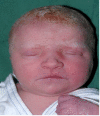Chromosome r(10)(p15.3q26.12) in a newborn child: case report
- PMID: 19968867
- PMCID: PMC2794276
- DOI: 10.1186/1755-8166-2-25
Chromosome r(10)(p15.3q26.12) in a newborn child: case report
Abstract
Background: Ring chromosome 10 is a rare cytogenetic finding. Of the less than 10 reported cases we have found in the literature, none was characterized using high-resolution microarray analysis. Ring chromosomes are frequently unstable due to sister chromatid exchanges and mitotic failures. When mosaicism is present, the interpretation of genotype-phenotype correlations becomes extremely difficult.
Results: We report on a newborn girl with growth retardation, microcephaly, congenital heart defects, dysmorphic features and psychomotor retardation. Karyotyping revealed a non-mosaic apparently stable ring chromosome 10 replacing one of the normal homologues in all analyzed metaphases. High-resolution oligonucleotide microarray analysis showed a de novo approximately 12.5 Mb terminal deletion 10q26.12 -> qter and a corresponding 285 kb terminal deletion of 10pter -> p15.3.
Conclusion: This case demonstrates that an increased nuchal translucency thickness detected by early ultrasonography should preferably lead to not only QF-PCR for the diagnosis of Down syndrome but also karyotyping. In the future, microarray analysis, which needs further evaluation, might become the method of choice. The clinical phenotype of our patient was in agreement with that of patients with a terminal 10q deletion. For the purpose of genotype-phenotype analysis, there seems to be no need for a "ring syndrome" concept.
Figures




Similar articles
-
Ring chromosome 10: report on two patients and review of the literature.J Appl Genet. 2013 Feb;54(1):35-41. doi: 10.1007/s13353-012-0128-7. Epub 2012 Dec 18. J Appl Genet. 2013. PMID: 23247912 Review.
-
Increased nuchal translucency, hydrops fetalis or hygroma colli. A new test strategy for early fetal aneuploidy detection.Fetal Diagn Ther. 2001 Jul-Aug;16(4):211-4. doi: 10.1159/000053912. Fetal Diagn Ther. 2001. PMID: 11399881
-
46,XY,r(8)/45,XY,-8 Mosaicism as a Possible Mechanism of the Imprinted Birk-Barel Syndrome: A Case Study.Genes (Basel). 2020 Dec 9;11(12):1473. doi: 10.3390/genes11121473. Genes (Basel). 2020. PMID: 33316910 Free PMC article.
-
Chromosome deletions in 13q33-34: report of four patients and review of the literature.Am J Med Genet A. 2008 Feb 1;146A(3):337-42. doi: 10.1002/ajmg.a.32127. Am J Med Genet A. 2008. PMID: 18203171 Review.
-
Discordant phenotypes in a mother and daughter with mosaic supernumerary ring chromosome 19 explained by a de novo 7q36.2 deletion and 7p22.1 duplication.Am J Med Genet A. 2011 Apr;155A(4):885-91. doi: 10.1002/ajmg.a.33918. Epub 2011 Mar 17. Am J Med Genet A. 2011. PMID: 21416596
Cited by
-
Terminal 10q26.12 deletion is associated with neonatal asymmetric crying facies syndrome: a case report and literature review.Mol Cytogenet. 2021 Jul 13;14(1):36. doi: 10.1186/s13039-021-00554-1. Mol Cytogenet. 2021. PMID: 34256807 Free PMC article.
-
Cleft lip/palate, short stature, and developmental delay in a boy with a 5.6-mb interstitial deletion involving 10p15.3p14.Mol Syndromol. 2015 Feb;6(1):39-43. doi: 10.1159/000371404. Epub 2015 Jan 22. Mol Syndromol. 2015. PMID: 25852446 Free PMC article.
-
Human Ring Chromosomes - New Insights for their Clinical Significance.Balkan J Med Genet. 2013 Jun;16(1):13-20. doi: 10.2478/bjmg-2013-0013. Balkan J Med Genet. 2013. PMID: 24265580 Free PMC article.
-
Clinical, cytogenetic and molecular study of a case of ring chromosome 10.Mol Cytogenet. 2015 Apr 21;8:29. doi: 10.1186/s13039-015-0124-9. eCollection 2015. Mol Cytogenet. 2015. PMID: 25922618 Free PMC article.
-
Ring chromosome 10: report on two patients and review of the literature.J Appl Genet. 2013 Feb;54(1):35-41. doi: 10.1007/s13353-012-0128-7. Epub 2012 Dec 18. J Appl Genet. 2013. PMID: 23247912 Review.
References
LinkOut - more resources
Full Text Sources
Miscellaneous

